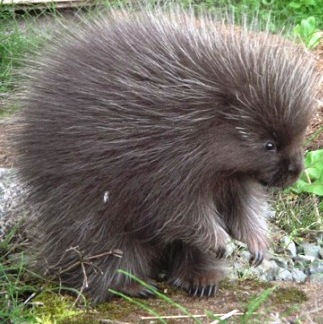|
The single largest group of mammals is the Rodentia. Most people are familiar with mice, rats, hamsters, and guinea pigs, which are commonly kept as pets. The Rodentia also includes beavers, muskrats, porcupines, woodchucks, chipmunks, squirrels, prairie dogs, marmots, chinchillas, voles, lemmings, and many others.
Most rodents are herbivorous, but some are omnivorous, and others prey on insects. Rodents show a wide range of lifestyles, ranging from burrowing forms such as gophers and mole rats to tree-dwelling squirrels and gliding "flying" squirrels, from aquatic capybaras and muskrats to desert specialists such as kangaroo rats and jerboas.
Despite their great species diversity, all rodents share common features. Rodents have a single pair of incisors in each jaw, and the incisors grow continually throughout life. The incisors have thick enamel layers on the front but not on the back; this causes them to retain their chisel shape as they are worn down. There are no canines, and typically only a few molars at the rear of the jaws. Rodents gnaw with their incisors by pushing the lower jaw forward, and chew with the molars by pulling the lower jaw backwards. In conjunction with these chewing patterns, rodents have large and complex jaw musculature, with modifications to the skull and jaws to accommodate it.
Porcupine: Weighing approximately 15 pounds, porcupines are the largest of Alaska's rodents except for beavers. Porcupines are found everywhere in Alaska except the Alaska Peninsula and Kodiak, Nunivak, and St. Lawrence islands. In winter, porcupines primarily eat trees' inner bark; in summer, they eat trees' buds and young leaves. Porcupines can cause forest management problems when they eat terminal buds or eating bark all the way around trees, though in most parts of Alaska there are not enough porcupines to cause significant damage. Though porcupine's quills discourage most predators, fishers, lynx, wolves, coyotes, and wolverines have developed methods of killing porcupines safely. Porcupine quills are used by Alaska Natives for decoration of clothing; these are collected by cornering porcupines and tapping them with a
Styrofoam paddle. The porcupine didn't reached Alaska until the last ice age.
Pika: Pikas have stocky bodies, short legs, large round ears, and are almost tailless. A distinct grayish patch on the shoulder and neck forms the "collar" from which the collared pika derives its name, appearing in definite contrast to the white fur on its chest and stomach. Pikas have fur-covered feet, but bare toe pads. Their sharp, curved claws help them climb from rock to rock with ease. Pikas are highly alert, possessing excellent hearing and vision. When fully grown, they weigh about 5 ounces Collared Pikas are common in the mountains of central and southern Alaska, particularly above timberline. They are very vocal animals, calling loudly to one another with short, sharp sounds that may be alarm calls or have a role in courtship. Their hearing and vision are excellent, and they climb with agility. They require a rocky area for cover, and a nearby meadow or other patch of vegetation where they can forage. Although winter conditions are harsh, Collared Pikas do not hibernate. In the summer they accumulate piles of cut grass and other vegetation to get them through winter, and yet they must still do some winter foraging.
Flying Squirrel: The northern flying squirrel is a gliding mammal that is incapable of true flight like birds and bats. There are 25 subspecies across North America with Interior Alaska being the most northern and western limit of the species' range. Adult flying squirrels average 4.9 ounces in weight and 12 inches in total length. The tail is broad, flattened, and feather-like. A unique feature of the body is the lateral skin folds on each side that stretch between front and hind legs and function as gliding membranes. This squirrel is nocturnal and has large eyes that are efficient on the darkest nights. Eye shine color is a distinctive reddish-orange. Flying squirrel pelage is silky and thick with the top of the body light brown to cinnamon, the sides grayish, and the belly whitish.
Voles: Voles are mice that have fuzzy coats and short tails. They mainly live in and eat grass. They are scientifically distinguished from other Alaska mice by having the grinding surfaces of the molars flat-crowned with an enamel pattern composed of alternating triangles. Seven species of voles occur in Alaska. There are two genera of voles in Alaska within the family Muridae. The red-backed voles have red-colored backs and live in more forested habitats that provide a more catholic diet. The other voles, belonging to the genus Microtus, are colored brown or gray and are mainly found in habitats with grass. They range in size from 8-112 grams. Voles live in all habitats in Alaska except on bare rocks and glaciers.
|







